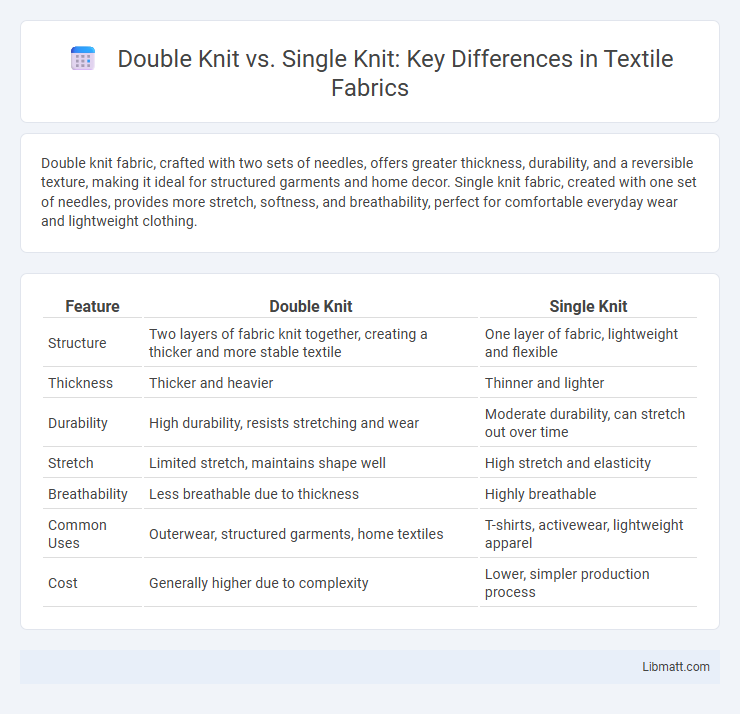Double knit fabric, crafted with two sets of needles, offers greater thickness, durability, and a reversible texture, making it ideal for structured garments and home decor. Single knit fabric, created with one set of needles, provides more stretch, softness, and breathability, perfect for comfortable everyday wear and lightweight clothing.
Table of Comparison
| Feature | Double Knit | Single Knit |
|---|---|---|
| Structure | Two layers of fabric knit together, creating a thicker and more stable textile | One layer of fabric, lightweight and flexible |
| Thickness | Thicker and heavier | Thinner and lighter |
| Durability | High durability, resists stretching and wear | Moderate durability, can stretch out over time |
| Stretch | Limited stretch, maintains shape well | High stretch and elasticity |
| Breathability | Less breathable due to thickness | Highly breathable |
| Common Uses | Outerwear, structured garments, home textiles | T-shirts, activewear, lightweight apparel |
| Cost | Generally higher due to complexity | Lower, simpler production process |
Introduction to Knitting: Double Knit vs Single Knit
Double knit fabric consists of two layers of interlocked knitting, offering greater thickness, warmth, and durability compared to single knit, which features a single layer of yarn loops. Single knit fabric is lighter, stretchier, and more breathable, making it ideal for casual wear and summer garments, while double knit suits structured apparel and cooler climates. Understanding these differences helps you choose the right knit type for your sewing projects based on texture, flexibility, and insulation needs.
Understanding Double Knit Fabrics
Double knit fabrics are created using two sets of needles, resulting in a thicker, more durable material with excellent stretch and recovery properties, making them ideal for structured garments and activewear. These fabrics have a smooth surface on both sides, providing a versatile finish that resists curling and fraying, unlike single knit fabrics, which are lighter and more prone to distortion. Choosing double knit fabric for your projects ensures better shape retention and longevity, especially in garments requiring stability and resilience.
Exploring Single Knit Fabrics
Single knit fabrics feature a construction where each stitch is formed from a single loop of yarn, resulting in a lightweight, breathable material ideal for T-shirts and casual wear. These fabrics exhibit a smooth face and a slightly textured back, promoting flexibility and comfort while maintaining moderate stretch. Single knit textiles are highly favored for their ease of printing and dyeing, making them versatile for fashion and activewear applications.
Structural Differences Between Double and Single Knit
Double knit fabric consists of two layers of knitted fabric interlocked together, creating a thicker, more durable, and reversible material with minimal stretch. Single knit fabric is made from a single layer of loops, resulting in a lighter, more flexible fabric that tends to curl at the edges and has greater stretchability. The structural complexity of double knit provides enhanced stability and insulation compared to the simpler, more breathable construction of single knit.
Fabric Texture and Appearance Comparison
Double knit fabric features a thicker, more structured texture, providing a smooth, firm surface on both sides, while single knit fabric offers a lighter, stretchier feel with a visibly looser texture and distinct front and back sides. Double knit's dense construction results in a polished, wrinkle-resistant appearance ideal for tailored garments, whereas single knit showcases a softer drape and more casual look suitable for everyday wear. Your choice between double knit and single knit ultimately depends on the desired fabric weight, texture, and garment style.
Durability and Strength: Which is Better?
Double knit fabric offers superior durability and strength compared to single knit due to its double-layered construction, which provides enhanced resistance to wear and tear. Single knit, while more lightweight and flexible, tends to stretch out and lose shape faster under frequent use. For applications requiring long-lasting performance and stronger structural integrity, double knit is the preferred choice.
Applications and Best Uses for Each Knit Type
Double knit fabric offers excellent durability and structure, making it ideal for tailored garments, activewear, and home textiles like upholstery and curtains. Single knit fabric is softer and more breathable, perfect for casual clothing, t-shirts, and lightweight layers where comfort and flexibility are priorities. Your choice depends on whether you need the resilience and thickness of double knit or the lightweight, stretchy qualities of single knit.
Warmth and Breathability: Double Knit vs Single Knit
Double knit fabric offers greater warmth due to its thicker, denser construction, trapping heat more effectively than single knit. Single knit, being lighter and more porous, provides superior breathability, allowing moisture and air to circulate freely. Your choice depends on whether you prioritize insulation for colder conditions or ventilation for comfort and temperature regulation.
Cost and Production Considerations
Double knit fabrics typically incur higher production costs due to their complex structure requiring more yarn and advanced machinery compared to single knit fabrics. Single knit fabrics are more cost-effective to produce, benefiting from faster manufacturing speeds and less material consumption. Businesses often choose single knit for budget-conscious projects, while double knit is preferred for durable, high-quality garments despite the increased expense.
Choosing the Right Knit for Your Project
Double knit fabrics offer greater thickness, durability, and warmth, making them ideal for structured garments like sweaters and jackets, while single knit fabrics provide more stretch, breathability, and lightweight comfort, perfect for t-shirts and casual wear. Your project's requirements for texture, flexibility, and insulation will determine the best knit choice, with double knit excelling in support and longevity, and single knit favoring softness and ease of movement. Consider the final garment's function and desired drape to select the appropriate knit that balances aesthetics and performance.
Double Knit vs Single Knit Infographic

 libmatt.com
libmatt.com